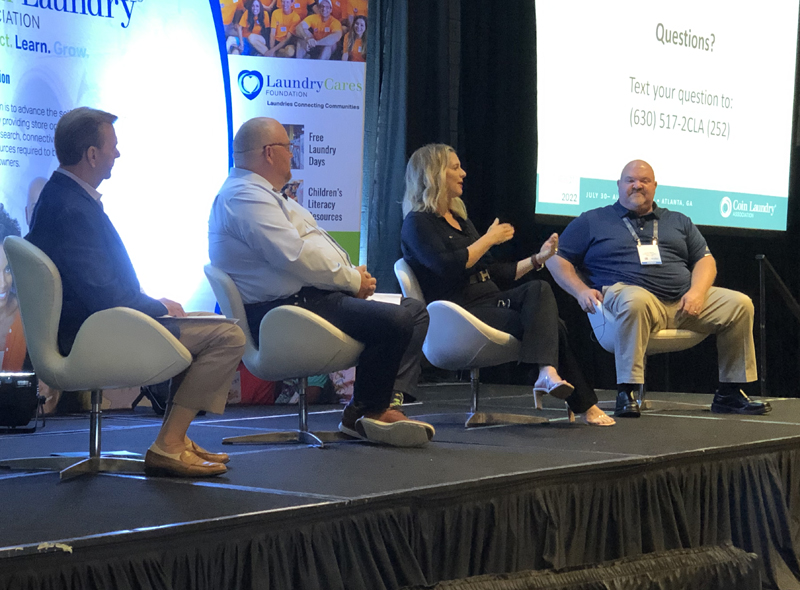Many laundromat owners have taken their self-service business to the next level by adding wash-dry-fold and pickup-and-delivery services. What’s more, those who already provide their customers these full-service offerings are raising the bar.
Residential wash-dry-fold with a home delivery element has been one of the hottest topics of conversation on the exhibit floor at Clean 2022 in Atlanta. And, on the third day of the trade show, the Coin Laundry Association brought that conversation to the seminar rooms, with a panel discussion on the topic.
The session was moderated by Neal Shapiro, the owner of WashTime on Fullerton in Chicago. His panelists included Amy Martinez-Monfort, Tampa Laundry Company; Dave Menz, Queen City Laundry; and Kent Wales, Happy Laundry & Dry Cleaning.
“It’s not rocket science, but it is the most complex thing to do within our industry at scale,” said Menz, who explained that he got into the pickup-and-delivery business after attending Clean 2015.
“It was a combination of being naïve and ambitious,” he added. “We had been in business for seven or eight years at the time, and our stores were starting to plateau. I had all of this equipment sitting there. I thought you just get a van and go pick up laundry. I was so naïve.”
Over the years, Menz dialed in his business, realizing that “quality is twice as important as speed” when it comes to full-service laundry – and that his team can be “efficient without being in a rush.”
He added that his production benchmark for new employees is the ability to process 30 pounds of laundry per hour.
With regard to labor, he suggested that if laundry owners build a culture that attracts the right type of people, it can serve as their secret sauce.
“Money is seldom the only answer,” Menz noted. “It’s a combination of things – putting employees in a position to win, giving them the right tools, providing mentorship and empowering them.”
At Tampa Laundry Company, Martinez-Monfort said she had been able to retain her staff throughout the pandemic.
“For example, we will hold financial literacy classes for employees, offer cell phone allowances – and provide other benefits beyond wages.”
Wales explained that he actively looks for needs among his staff. “Ask the team what benefits would most help them,” he suggested.
Above all, the entire panel agreed on two key points regarding staffing:
- Talk to your employees, because they probably won’t come to you directly. You need to go to them.
- Do all you can to retain quality employees and keep the team you have in place.
Next, Shapiro shifted his panel’s focus to marketing a full-service laundry operation.
“The most compelling marketing message is not what we say about ourselves, but what our customers say about us,” Martinez-Monfort noted. “At the end of the day, people buy from someone they know. A customer will tell a friend about us, and that person will tell a friend. Word of mouth is very powerful.”
Branding your wash-dry-fold business also is a critical element, Martinez-Monfort added.
“No one wants to think of their clothes going to a stereotypical ‘laundromat,’” she said. “With pickup and delivery, you’re asking customers to trust you with their favorite clothing items, so you have to find a way to differentiate yourself. Build a brand. Design a logo for yourself. You won’t even get through the door without a brand.”
Also part of Martinez-Monfort’s marketing budget are funds earmarked specifically for any errors in garment processing.
“When we make a mistake, we pay 100 percent replacement value,” she said. “We’re building trust and long-term relationships. If not, we will lose customers. I know you’re not going to want to write that check, but when that customer comes back to you after a mistake, you’ll be happy you did.”
While all successful operators, the panelists weren’t shy about sharing rookie mistakes in the business.
“I tend to get over my skis in everything,” Menz admitted. “And we were initially servicing way too big of an area. I felt that it eventually would become worth it, which was ridiculous. I needed to be focusing on more of a boutique experience for our customers.”
He eventually reduced the size of his PUD territory by 40 percent – and went from losing money to growing his business by 20 percent.
“You can do everything right,” he advised, “but if you get the territory wrong, you’ll continue to spin your wheels.”
Martinez-Monfort shared an incident where she also took on a bit more than her business could handle. She had landed the tablecloth business for a local party planner – and soon realized it cost more to process the items than she anticipated.
“I had to back off and tell the client we weren’t set up properly for her type of account,” she recalled. “So, always do your research, because the grass sometimes can look greener.”
She also added a tip for all of the session’s attendees, regarding social media: “Don’t set up accounts if you’re not prepared to pay attention to them and respond to feedback. If I get a one-star review, it’s like a kick in the gut – and I respond immediately. Don’t just set it and forget it.”
Lastly, for those owners attending the Clean Show with strictly self-service operations or perhaps some drop-off business, the panel was encouraging.
A drop-off wash-dry-fold service is a great place, they all concurred – urging laundromat owners to take sensible baby steps toward the goal of a home delivery business.
“With the right systems and processes in place, you can build a scalable business,” Menz said. “It doesn’t have to be more complicated.
“Plus, when you can scale your operation and still offer that niche, boutique experience, you can price it based on the value you offer,” he added. “At the end of the day, business is about people and math – deliver that value, and then make the math work for you.”












